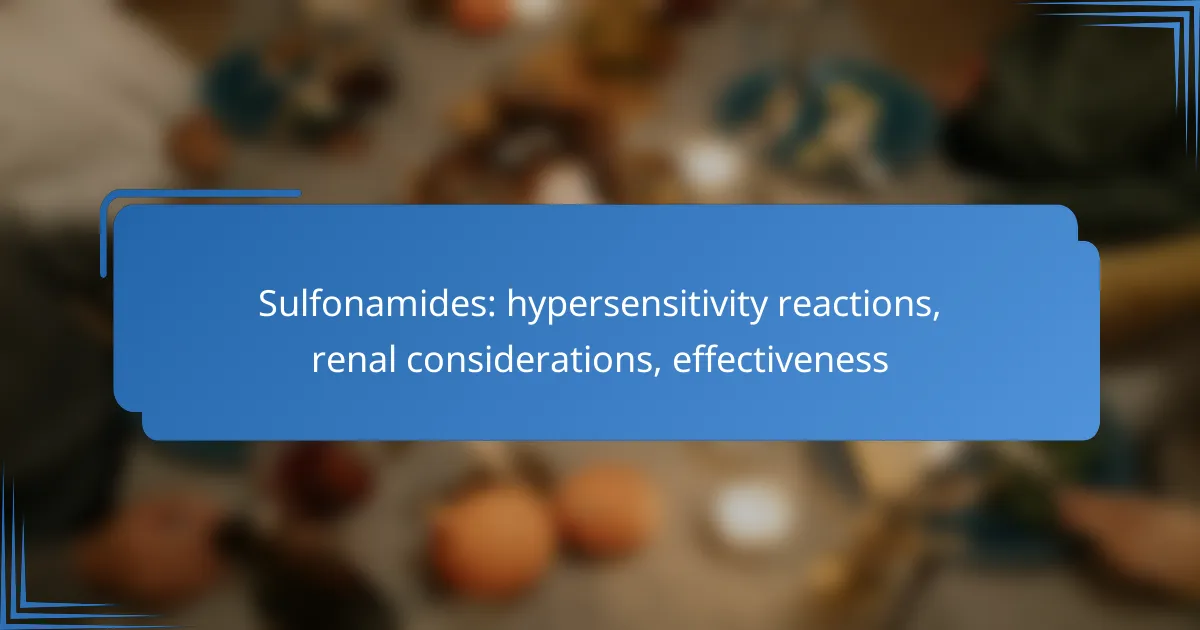Sulfonamides are effective antibiotics that inhibit bacterial growth by blocking folic acid synthesis, making them particularly useful for treating urinary tract infections and certain types of pneumonia. However, their use can be complicated by hypersensitivity reactions, which range from mild allergies to severe, life-threatening conditions. Additionally, sulfonamides can adversely affect renal function, necessitating careful monitoring, especially in patients with existing kidney issues.

What are the hypersensitivity reactions to sulfonamides?
Hypersensitivity reactions to sulfonamides can vary from mild allergic responses to severe, life-threatening conditions. These reactions are immune-mediated and can occur shortly after administration or after prolonged use.
Common allergic reactions
Common allergic reactions to sulfonamides include skin rashes, itching, and fever. These symptoms can manifest within days of starting the medication and often resolve upon discontinuation.
Other frequent reactions may involve gastrointestinal disturbances, such as nausea or vomiting. Patients should be monitored for these symptoms, especially when starting sulfonamide therapy.
Severe reactions like Stevens-Johnson syndrome
Severe reactions to sulfonamides can include conditions like Stevens-Johnson syndrome (SJS) and toxic epidermal necrolysis (TEN), which are rare but serious. These syndromes involve extensive skin and mucous membrane damage and can be life-threatening.
Patients experiencing severe skin reactions, fever, or systemic symptoms should seek immediate medical attention. Early recognition and discontinuation of the drug are critical to improving outcomes.
Symptoms of hypersensitivity
Symptoms of hypersensitivity to sulfonamides may include a combination of skin rashes, respiratory issues, and gastrointestinal symptoms. Skin reactions can range from mild rashes to severe blistering.
Other systemic symptoms might involve fever, malaise, or joint pain. It’s essential for patients to report any unusual symptoms to their healthcare provider promptly to ensure appropriate management.

How do sulfonamides affect renal function?
Sulfonamides can impact renal function primarily through their potential to cause hypersensitivity reactions and crystalluria, which may lead to kidney damage. Monitoring renal function is crucial when using these medications, especially in patients with pre-existing kidney conditions.
Impact on kidney health
Sulfonamides can lead to acute kidney injury (AKI) by causing obstruction in the renal tubules due to crystallization. This crystalluria occurs when the drug precipitates in the urine, particularly in patients with low urine output or dehydration. Maintaining adequate hydration can help mitigate this risk.
In some cases, sulfonamides may also provoke allergic reactions that can result in interstitial nephritis, characterized by inflammation of the kidney interstitium. This condition can impair kidney function and may require discontinuation of the drug.
Risk factors for renal complications
Several factors can increase the risk of renal complications when using sulfonamides. These include pre-existing renal impairment, dehydration, and concurrent use of other nephrotoxic medications. Patients with a history of kidney stones or urinary tract obstructions may also be at higher risk.
To minimize these risks, healthcare providers should assess renal function before initiating sulfonamide therapy and ensure that patients are well-hydrated. Regular monitoring of kidney function during treatment is advisable, particularly for those with identified risk factors.

What is the effectiveness of sulfonamides?
Sulfonamides are effective antibiotics primarily used to treat bacterial infections. They work by inhibiting bacterial growth through the blockage of folic acid synthesis, making them suitable for various infections, particularly urinary tract infections and certain types of pneumonia.
Clinical efficacy in treating infections
Sulfonamides demonstrate significant clinical efficacy in treating a range of infections, especially those caused by susceptible strains of bacteria. Commonly prescribed sulfonamides include sulfamethoxazole combined with trimethoprim, which is effective against urinary tract infections and respiratory infections. Their effectiveness can vary based on the specific pathogen and local resistance patterns.
It is crucial to consider the patient’s clinical condition and the type of infection when prescribing sulfonamides. For example, they are often less effective against certain resistant bacteria, necessitating susceptibility testing in some cases.
Comparison with other antibiotics
When comparing sulfonamides to other antibiotics, such as penicillins or cephalosporins, their spectrum of activity and mechanism of action differ significantly. While sulfonamides are effective against a specific range of bacteria, penicillins are often preferred for treating streptococcal infections due to their higher efficacy and lower resistance rates.
Additionally, sulfonamides may have a higher incidence of hypersensitivity reactions compared to some other antibiotic classes. Therefore, clinicians should weigh the benefits and risks when choosing sulfonamides over alternatives, particularly in patients with a history of drug allergies.

What are the precautions for using sulfonamides in Canada?
In Canada, precautions for using sulfonamides include assessing patient history for hypersensitivity reactions, monitoring renal function, and ensuring appropriate prescribing practices. These measures help minimize adverse effects and enhance the drug’s effectiveness.
Guidelines for prescribing
When prescribing sulfonamides, healthcare providers should evaluate the patient’s medical history for any previous allergic reactions to sulfonamides or related compounds. It’s essential to consider alternative antibiotics for patients with a known hypersensitivity to this class of drugs.
Additionally, clinicians should be cautious when prescribing sulfonamides to patients with renal impairment. Dosing adjustments may be necessary to avoid toxicity, and close monitoring is recommended to ensure patient safety.
Monitoring renal function
Regular monitoring of renal function is crucial for patients on sulfonamides, particularly those with pre-existing kidney issues. Baseline renal function tests should be conducted before starting treatment, followed by periodic assessments during therapy.
Healthcare providers should be vigilant for signs of renal toxicity, such as changes in urine output or elevated serum creatinine levels. If any abnormalities are detected, it may be necessary to discontinue the sulfonamide and consider alternative treatment options.

What are the alternatives to sulfonamides?
Alternatives to sulfonamides include various antibiotic classes and emerging treatments that can effectively address bacterial infections. These options are particularly relevant for patients with hypersensitivity reactions to sulfonamides or those requiring different therapeutic approaches.
Other antibiotic classes
Other antibiotic classes that can serve as alternatives to sulfonamides include penicillins, cephalosporins, and macrolides. Penicillins, such as amoxicillin, are commonly used for respiratory infections, while cephalosporins like cefalexin are effective against skin and soft tissue infections. Macrolides, including azithromycin, are often prescribed for atypical pneumonia and certain STIs.
When selecting an alternative, consider the specific bacterial infection and patient history. For instance, patients with a history of penicillin allergy may be better suited for cephalosporins or macrolides, depending on their sensitivity profiles.
Emerging treatments for bacterial infections
Emerging treatments for bacterial infections include novel antibiotics, bacteriophage therapy, and antimicrobial peptides. Novel antibiotics, such as those targeting resistant strains, are being developed to combat antibiotic resistance. Bacteriophage therapy utilizes viruses that specifically target bacteria, offering a tailored approach to treatment.
Antimicrobial peptides, which are naturally occurring molecules, show promise in disrupting bacterial membranes. These treatments are still largely in research phases but may provide effective alternatives in the near future, especially for multidrug-resistant infections.

How to manage sulfonamide hypersensitivity?
Managing sulfonamide hypersensitivity involves immediate identification and treatment of the allergic reaction, followed by long-term strategies to prevent future occurrences. Recognizing symptoms early and implementing appropriate interventions are crucial for patient safety.
Immediate treatment options
Upon suspecting sulfonamide hypersensitivity, the first step is to discontinue the medication immediately. Supportive care may include administering antihistamines for mild reactions or corticosteroids for more severe symptoms. In cases of anaphylaxis, epinephrine should be given without delay, and emergency medical services should be contacted.
Monitoring the patient closely is essential, especially for respiratory distress or significant skin reactions. Providing intravenous fluids may be necessary if the patient shows signs of shock or dehydration.
Long-term management strategies
Long-term management of sulfonamide hypersensitivity focuses on avoiding future exposure to sulfonamide-containing medications. Patients should be educated about their allergy and provided with a clear list of medications to avoid, including some diuretics and certain antibiotics.
Regular follow-ups with healthcare providers can help manage any related conditions and monitor for alternative medications that are safe for the patient. Additionally, wearing a medical alert bracelet can inform emergency personnel of the allergy in case of an emergency.
